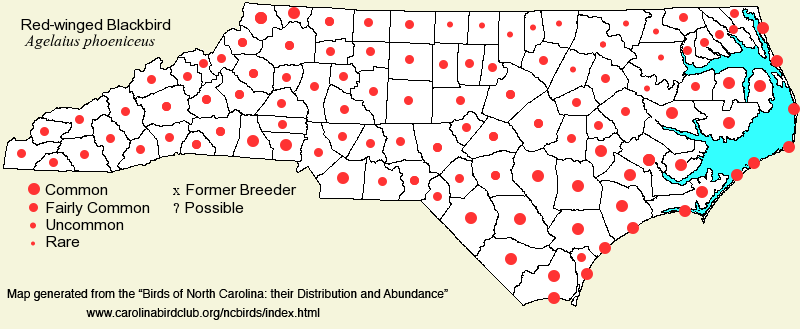 |  |
|
Red-winged Blackbird - Agelaius phoeniceus ICTERIDAE Members: | Search Common: Search Scientific: |
|
|
|||||||
| General Comments | The Red-winged Blackbird has probably been the most heavily studied species in North America, and numerically it is one of the most abundant. It nests across all of North America except for the Far North, and it winters across most of the United States. In North Carolina, it occurs in all 100 counties at all times of the year but is scarce to rare in many mountain counties in winter. It was assumed to be a common statewide breeding bird until the Breeding Bird Survey was established in the mid-1960's. Interestingly, the species is often missed on the 50 stops of the survey in parts of the northern Coastal Plain and Piedmont, indicating that it is uncommon, or at least localized to marshes and lake/pond edges, in parts of the state. For breeding, the species nests in fresh to slightly brackish marshes, lake and pond margins, ditches, and other wet grassy areas, usually in open country. In parts of the state, all that is required for a nesting territory is a small area of cattails and other tall grasses amid farmland. At other seasons, they form large flocks, often with Common Grackles, Brown-headed Cowbirds, and European Starlings, and feed in harvested croplands, fields, marshes, and other open country; they roost in marshes, dense grassy fields, and in swampy forests, often in groups of tens of thousands of birds. | ||||||
| Breeding Status | Breeder | ||||||
| NC BRC List | Definitive | ||||||
| State Status | |||||||
| U.S. Status | |||||||
| State Rank | S5B,S5N | ||||||
| Global Rank | G5 | ||||||
| Coastal Plain | Permanent resident, with migratory movements. In summer, common to very common in the eastern third of the region, as well as the southern portions; only fairly common and somewhat local in parts of the northwestern quarter of the region. At other seasons, common to locally abundant; clearly more numerous in winter than in summer. Peak counts: | ||||||
| Piedmont | Permanent resident, with migratory movements. Common, though can be local, across the region in summer; fairly common in a few areas, such as near the Virginia border. At other seasons, erratic from week to week, but generally common in the eastern and southern portions; can be locally abundant at roosts, but also can be scarce in severe weather. Farther west, averages common in migration and fairly common in winter, but can be difficult to find at times in severe weather. Peak counts: | ||||||
| Mountains | Permanent resident, with migratory movements. In summer, generally common at low to middle elevations, up to about 4,000 feet; scarce at higher elevations. Can be common at times in migration; uncommon in winter at lower elevations (mainly below 3,000 feet), and rare higher. Peak counts: | ||||||
| Finding Tips |
None needed. **** | ||||||
| Attribution | LeGrand[2023-04-02], LeGrand[2012-11-08], LeGrand[2011-12-19] | ||||||
| NC Map Map depicts all counties with a report (transient or resident) for the species. | Click on county for list of all known species. |
| NC Breeding Season Map Map depicts assumed breeding season abundance for the species. |  |